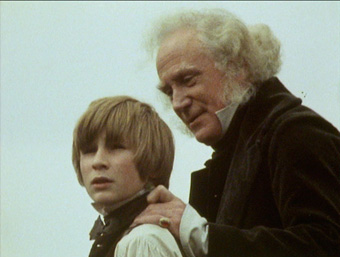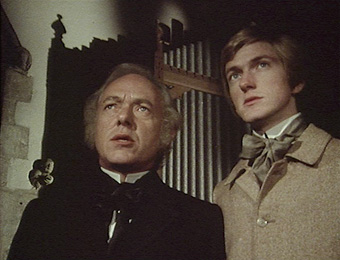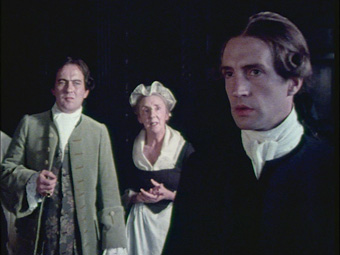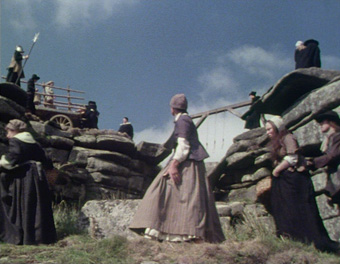|
Volume 3 of the BFI's DVD releases of the films in the BBC's annual Ghost Story slot – which by this point had become known as A Ghost Story for Christmas – contains three films as opposed to the two of previous volumes, but all are considerably shorter than their predecessors (there are also fewer special features on the disc). All three films here are based on short stories by M.R. James (check the reviews of previous volumes if the name is unfamiliar) from his 1904 anthology Ghost Stories of an Antiquary, and all were directed by Lawrence Gordon Clark, the man responsible for The Stalls of Barchester and A Warning to the Curious, both of which you'll find on Volume 2. Here, however, Clark was acting solely as director, the production having become the responsibility of the BBC's drama department and specifically producer Rosemary Hill. Clark had also abdicated his role as screenwriter, with the adaptations handled instead by writers Robin Chapman, John Bowen and David Rudkin.
As before, the films are arranged by production and transmission date and were the last of the Ghost Story films to be adapted from M.R. James. Lost Hearts was first shown at Christmas 1973 (on Christmas Day no less, which doubtless irked those for whom the day is supposed to be all about smiling children and artificial joviality), The Treasure of Abbot Thomas in 1974 and The Ash Tree in 1975. All three are period pieces, and despite some changes made to the original stories, all are very recognisably Jamesian in their characters, plots and detail.
One of my favourite things about Lost Hearts is, rather annoyingly, something I can't really discuss without spoiling the story's biggest and frankly most shocking surprise. I can't even allude to it without prompting a number of you to second guess what I'm trying to avoid revealing. And for maximum impact, this is one time when you really should go in cold.
It begins with 11-year-old Stephen, dressed in respectable clothing and a Brunelian top hat, being transported through the Lincolnshire countryside to the stately home of his elderly cousin, Mr. Abney. As his carriage approaches the Hall, Stephen briefly sees two wan-looking children standing in a field, their arms slowly arching in a synchronised wave. Seconds later they are gone.

On reaching the Hall, Stephen is greeted warmly by his cheerfully eccentric cousin, who seems particularly keen to confirm his age and the date of his upcoming twelfth birthday. Stephen also learns that he is not the first child to stay at the Abbey, but that the previous two visitors, a girl named Phoebe and a boy named Giovanni, both mysteriously disappeared. The presumption at the time was that Phoebe was taken by gypsies and Giovanni had run away, but as Stephen explores the grounds he repeatedly catches sight of a boy and a girl who may well be the ghosts of the two missing children.
And in terms of plot, that's all you'll get from me. It all feels quaintly old-fashioned and, by modern standards at least, not particularly threatening, with the ghosts standing on the periphery, their intentions teasingly uncertain. In one intriguing instance Stephen is walking with Mr. Abney and spots them looking down at him from an upstairs window; he is about to call out when they raise their fingers to their lips in a synchronised "shhh" gesture, which prompts him to instead remain silent about what he has just seen. It's later, when the spectral Giovanni enters Stephen's room at night, that their presence takes an altogether more sinister turn, with a seemingly hypnotised Stephen pulled from his slumber by the eerie drone and jangle of the hurdy-gurdy that the mortal Giovanni once treasured. It's genuinely unnerving sequence that builds to a splendidly handled (and quite graphic) shock revelation, the full implications of which only become clear in the scenes that follow.

Lost Hearts relies heavily on the creepiness of its two young ghosts, which has been affected a little by the passing of time. Certainly when they're grinning and waggling their overlong fingernails there's a sense of children play-acting at being scary and not quite pulling it off, but when their their movements fall into the rhythm of the hurdy-gurdy music in a slow dance of death, the effect is considerably more disconcerting. And while their deathly make-up may well have been influenced just a tad by Night of the Living Dead, it also uncannily anticipates a look that was to become popular for ghostly children in the later J-horror cycle.
Young Simon Gipps-Kent does rather well as Stephen, but it's Joseph O'Connor who effectively steals the film as the the cheerful Mr. Abney, combining a boffin's eccentricity with the warmth of a lively uncle to create a character seemingly incapable of harming another being, but who is clearly up to something from the moment we first meet him. The passing of time, of course, has provided some pointers here, and there will surely be few for whom the prospect of an old man inviting wayward young orphans back to his isolated house to stay does not set off a small bell of alarm.
| The Treasure of Abbot Thomas (1974) |
|
For a good part of its running time it would, I think, be fair to describe The Treasure of Abbot Thomas more as a detective story than a tale of the supernatural. I'd even go as far as to suggest that the investigative elements are, on the whole, more successfully realised than the ghost story they eventually and belatedly give way to.
It begins with an almost orgasmic séance being conducted by a Mrs. Tyson and her husband on behalf of the recently widowed Lady Dattering. Its failure, claim the Tysons, is likely due to the cynicism of Lady Dattering's son Peter (Paul Lavers), who is a scholar of the learned and level-headed Reverend Justin Somerton (Michael Bryant). Somerton is one of those rare film priests that I instantly take a liking to, a no-nonsense pragmatist who agrees to attend the next séance because he is "interested in all forms of the higher silliness" and who smartly exposes the Taylors as frauds. How could you not like this guy? It's Somerton who tells Peter about the titular Abbot Thomas, a self-proclaimed alchemist who was condemned as a charlatan and who is reputed to have hidden a large quantity of gold coins somewhere in the monastery. In the process of translating a document from Latin, the pair stumble on a clue to the location of the treasure, one that leads to a cryptic message on a stained glass window.

There's an almost Holmesian quality to Somerton and Peter's investigation, which peaks with the discovery of the hidden message and their dogged attempts to decode it (a splendidly executed montage that screenwriter John Bowen apparently disliked). So well handled is this process and so convincing the performances of Bryant and Lavers that there were times when I forgot I was watching a ghost story at all. Aside from Somerton's brief encounter with his own crippling vertigo when on the monastery ramparts, the signs that the story will take a supernatural turn are teasingly oblique – a wine stain on a drawing, an indistinct shape on a photographic negative, a monk who may or may not be listening to their discussion. We're approaching the climactic scene before we learn, rather suddenly, that the treasure is reputed to be spiritually protected.
What follows is in some ways a condensed retread of the cautionary tales told in Whistle and I'll Come to You and A Warning to the Curious, where the unearthing and removal of a previously buried object sees excavator pursued and traumatised by a ghostly guardian. But the cackling Abbot here is no match for the more indistinct horrors of Whistle's ill-defined spectre, and the goo that precedes him feels more Bernard Quatermass than M.R. James. The story still concludes on a suitably chilling note, a perfectly timed cut to black that leaves us to ponder on just what happened next.
Following his uncle's death, Sir Richard takes up his new post as the squire of the vast Castringham Hall estate. The exterior of the Hall is dominated by a large ash tree, a plant that Richard is advised to have cut down to prevent its roots from damaging the Hall's foundations. In touring the estate, Richard discovers that animals are being inexplicably found dead, and begins to be haunted by visions of his ancestor, Sir Matthew, whose damning testimony saw a woman named Anne Mothersole condemned as a witch.
Despite the characteristically gradual manner in which the story unfolds, there are twin hooks here in the shape of the finely judged performance of Edward Petherbridge (so wonderful as Newman Noggs in the Royal Shakespeare Company production of The Life and Adventures of Nicholas Nickleby) as both Richard and Sir Matthew, and what could be series regular Lawrence Gordon Clark's most confident direction yet. There's an almost sleight-of-hand economy to the storytelling here, with scenes and locations linked by unbroken conversation, the extent of the livestock sickness shown almost in passing, and the year established by a particular component of Richard's literary collection.

Particularly impressive is Clark's handling of the dual timeline structure, with the Sir Matthew's story at first unfolding as brief visions (or perhaps inherited memories?) and becoming more substantial as the film progresses. There are no date captions or voice-over clues to these temporal switches here, the trips into the past sometimes signalled only by differences in costume and hairstyle coupled with subtle alterations in delivery and language.
The significance of the titular ash tree is played down in the film itself until the climactic scenes, but hovers tantalisingly in the background whenever the suggestion is made that Richard should have it cut down. Only towards the end, when Richard moves into the room in which his great uncle slept, does the title makes it's mark. It's also here that Clark and writer David Rudkin (who also wrote the superb Penda's Fen for Alan Clarke the previous year) take a real risk by visualising creatures that were indistinctly described in the original story, particularly given the small budget they had to work with. But while they don't stand up to close inspection, when fleeting glimpsed they are actually quite creepy, and a wide shot in which we can just make out a number of them together in the moonlight – an almost exact recreation of a passage in the story – is genuinely unsettling. But the best frisson of all is delivered by the handling and the timing of the final cut to black, which references an earlier dialogue exchange and is every bit as sharp and unexpected as the one at the end of No Country for Old Men.
All three films were shot on 16mm film and are presented here in their 1.33:1 aspect ratio. The level of detail is often impressive, particularly on close-ups, and the contrast is generally well judged, though the black levels are a tad strong in some scenes in The Treasure of Abbot Thomas, and soften markedly for a few shots during one scene in The Ash Tree. There is also a more pronounced green hue to the picture here. The visible grain is to be expected from even medium speed 16mm stock of the period, and while there are dust spots evident throughout, only occasionally do they stand out.

The Dolby 2.0 mono soundtracks are clear and free of damage and background hiss. There is, however, a crispness to the trebles on The Ash Tree that is occasionally a little shrill. Earthier sounds, such as the beating of execution drums, are fine.
As with the previous two volumes, all of the extras have spoilers within them and should be watched or read after seeing the films. The introductions each carry specific spoiler warnings.
Introduction to Lost Hearts by Lawrence Gordon Clark (10:50)
The ever-amiable Clark discusses the move to the BBC's drama department and the changes this imposed (including a shorter shooting schedule), the tracking down of locations (a task he managed to retain for himself), working with child actors, and the use of hurdy-gurdy music. He also talks informatively about aspects of his camera technique, including the use of POV shots and how chance rather than planning provided the opening image of the carriage emerging from fog.
Introduction to The Treasure of Abbot Thomas by Lawrence Gordon Clark (10:39)
Clark here talks about lead actor Michael Bryant, the problems of securing the main location (no easy job a year after Pasolini has shot part of The Canterbury Tales there), the changes made to James' original story, his disappointment at how the climatic horror elements played, and his relationship with screenwriter John Bowen.
Introduction to The Ash Tree by Lawrence Gordon Clark (8:05)
For his last M.R. James adaptation for the BBC, Clark talks about the problems of finding the right location (there's an interesting post-filming story attached to this) and his delight at being able to work with the writer of Penda's Fen. Surprisingly, he regards this as one of his less successful James adaptations and feels that's it's not as scary as it should have been.
Booklet
Another fine booklet that includes short essays on Lost Hearts by Ramsey Cambell, on The Treasure of Abbot Thomas by Alex Davidson, and on The Ash Tree by Dick Fiddy. There are biographies of M.R. James by Reggie Oliver, and of Lawrence Gordon Clark by Simon Farquhar, plus a piece on the M.R. James stories from which the films were adapted by Robert Lloyd Parry, credits for the films, and even a production of one of Lawrence Gordon Clark's primitive storyboards for Abbot Thomas.
The third volume of the BFI's BBC Ghost Stories series is in some ways the best yet, with three films linked by their director, their producer, cinematographer John McGlashan, and the single anthology from which they are sourced. Despite the odd flaw, all three are solidly made and captivatingly told tales, well cast and performed, sometimes visually striking and making great use of location. The included introductions are welcome (though ironically should not be watched as introductions), and the booklet, as ever, is an essential read. Highly recommended.
|